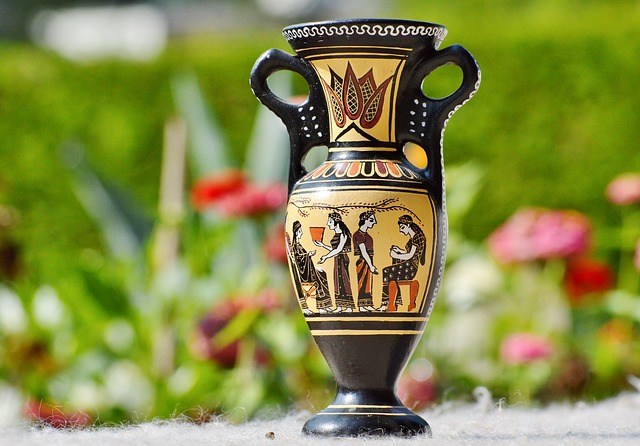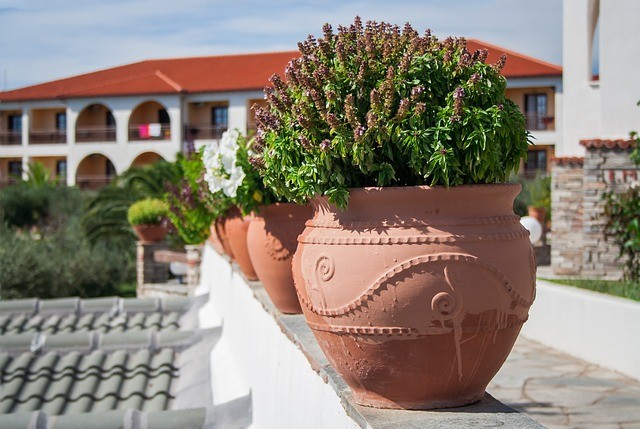Greek pottery tells us a story of pictorial art, representative of everyday life in ancient Greece.
Pottery vessels were a major source of transportation and preservation.
You can find Greek pottery shapes varying from cups, tea pots, coiled vases, to Greek amphoras, as they were used to preserve perfumes, wine, water, decor and much more.
Let’s venture into the fascinating world Greek pottery designs and Greek pottery styles – and how you can make them yourself!
Four Greek Pottery Styles
The four major Greek pottery styles include geometric, corinthian, black-figure, and red-figure pottery.
Geometric style pots are decorated with fine patterns of symbols, such as the herringbone, triangles, as well as human figures and animal shapes. These figures are placed symmetrically on the pot.
The Corinthian style inhabits Asian motifs and influences, including exotic or even mythological creatures, like the siren, griffin, and sphinx.
The black-figure Greek pottery style introduces narrative scenes and human figures.
The illustrious pieces of art were created with black glaze, carved or painted onto the pots and then fired to make it more prominent along a light backdrop.
Similar to black-figure pottery, red-figure pottery displays reddish figures, which are also painted upon a light backdrop.
The geometric version of Greek pottery involves more painting than carving.
With pervasive use of the brush, the art is more expressive in terms of mood and facial features as opposed to the standard 2D figurine patterning portrayed in the previous three Greek pottery designs.
Greek Pottery Techniques
The vases are made of baked clay or terra cotta. The clay was mixed with water in large outdoor pools so that impurities and pebbles would sink to the bottom.
The mixture was then drained into a second outdoor pool and left to dry, forming the refined clay to be used for potting.
First, the vase is thrown and shaped on the potter’s wheel. Then it is pieced together.

To paint a Greek vase, the painter used a refined liquid clay, similar to the color of the vase itself. The artist then used a muffle kiln, an oven, or insulated chamber to over-glaze the painted designs.
The vase paintings take on the form of black glaze once they are fired.
The artist used a sharp point made of wood or metal to add prominent details and features to their design, such as facial expressions or movement among individuals.
Greek Pottery From Home
Follow these five steps to make your very own Greek pottery right from home.
- Throwing
First, place your desired amount of clay at the center of the rotating potter wheel.
As the wheel is spinning, pull the clay into the appropriate vase shape you wish to create. Make sure to keep a steady hand and move carefully as you ease and slightly pull at the clay.
In order to separate your vase from the wheel, pull a wire cord through the base. This ensures the vase is neatly intact and you don’t smudge or push into its base.
Set the vase aside and let it harden to a dry leather consistency before proceeding with part two.
- Turning the Clay
After your clay has been thrown and dried, it is now time to turn the clay.
Turning is to remove excess clay, such as any unwanted thickness or uneven areas in your vase.
You want your vase to be semi-hard before placing it back onto the wheel to refine it.
As the wheel rotates, use tools made of metal or wood to trim and reshape until it is perfect.
- Joining the Clay
While your vase is still on the wheel, you can join new sections, like handles, the lip, neck, as well as decorative shapes.
These attachments should have been created separately and previously before building the actual vase.
You want to join the clay pieces, but also mold and press them together so that they are neatly conjoined.
- Burnishing
Now it is time to smoothen the surface of your vase to get it ready for painting. This is called burnishing.
Burnish your vase by rubbing it with a smooth tool made of wood, leather, or stone.
The tool must be hard enough to toughen your clay so that it is not susceptible to scratches and scraping.
- Painting
There are several methods for painting your vase.
A simple method is to use terra sigillata (also known as “terra sig”), a material made of fine slip. Terra sig is a mixture of refined clay, water, and deflocculant, and is best applied when your pot is bone dry.
You can also go with the classic method used in ancient Greek pottery: diluted glaze.
Diluted glaze is best used to paint intricate individual forms, garments, and expressions to narrate a story.
The video below shows another example of making Greek pottery.
Ancient Greek pottery is so detailed and intricate, it gives us a clear idea of the mythological themes and values of the ancient Greeks.
Get inspired and create your version of illustrious Greek pottery today.
Have you tried making your own Greek pottery?






